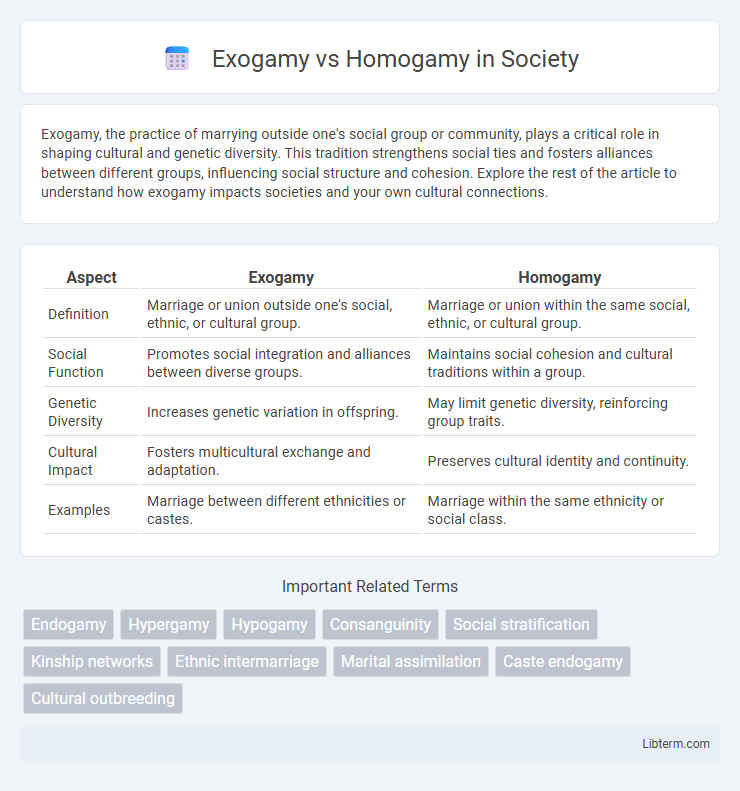Exogamy, the practice of marrying outside one's social group or community, plays a critical role in shaping cultural and genetic diversity. This tradition strengthens social ties and fosters alliances between different groups, influencing social structure and cohesion. Explore the rest of the article to understand how exogamy impacts societies and your own cultural connections.
Table of Comparison
| Aspect | Exogamy | Homogamy |
|---|---|---|
| Definition | Marriage or union outside one's social, ethnic, or cultural group. | Marriage or union within the same social, ethnic, or cultural group. |
| Social Function | Promotes social integration and alliances between diverse groups. | Maintains social cohesion and cultural traditions within a group. |
| Genetic Diversity | Increases genetic variation in offspring. | May limit genetic diversity, reinforcing group traits. |
| Cultural Impact | Fosters multicultural exchange and adaptation. | Preserves cultural identity and continuity. |
| Examples | Marriage between different ethnicities or castes. | Marriage within the same ethnicity or social class. |
Understanding Exogamy: Definition and Significance
Exogamy refers to the social practice of marrying outside one's specific social group, clan, or community, promoting genetic diversity and fostering alliances between distinct groups. This custom plays a crucial role in preventing inbreeding and encouraging broader social cohesion by establishing connections beyond immediate familial or ethnic boundaries. Understanding exogamy highlights its significance in shaping societal structures and influencing patterns of human relationships across cultures.
Homogamy Explained: Key Concepts and Types
Homogamy refers to the practice of individuals marrying partners who share similar social, cultural, and economic backgrounds, such as education level, ethnicity, religion, or socioeconomic status. Key types of homogamy include educational homogamy, where spouses have comparable educational attainment, and ethnic homogamy, emphasizing shared cultural heritage and traditions. Understanding homogamy helps explain social cohesion and stability within communities by reinforcing common values and reducing interpersonal conflicts.
Historical Context: Evolution of Marriage Patterns
Exogamy, practiced in many ancient societies, mandated marriage outside one's social group to build alliances and ensure genetic diversity, shaping early kinship systems and community cohesion. Homogamy emerged prominently in more stratified societies, emphasizing marital unions within similar social, economic, or cultural groups, reinforcing social stability and inheritance patterns. Over time, these contrasting marriage patterns influenced demographic trends, social organization, and the evolution of family structures globally.
Cultural Influences on Exogamy and Homogamy
Exogamy and homogamy represent distinct marriage patterns influenced strongly by cultural norms and values. Exogamy promotes marital unions outside specific social, ethnic, or kinship groups to foster alliances and genetic diversity, often seen in cultures emphasizing clan integration and social cohesion. Homogamy, driven by shared cultural backgrounds, social status, religion, or ethnicity, reinforces group identity and stability by encouraging marriages within similar cultural or social boundaries.
Societal Benefits and Challenges of Exogamy
Exogamy, the practice of marrying outside one's social group, promotes genetic diversity and fosters cross-cultural understanding, which can strengthen societal cohesion and reduce ethnocentric biases. It challenges traditional social boundaries by encouraging the blending of different customs and values, potentially leading to greater social integration and innovation. However, exogamy may also face resistance from cultural groups prioritizing homogeneity and can create complexities in navigating conflicting familial and social expectations.
Homogamy’s Impact on Social Cohesion and Identity
Homogamy, the practice of marrying within a specific social group, strengthens social cohesion by reinforcing shared values, cultural norms, and identity. It fosters social stability and continuity by maintaining group boundaries and promoting solidarity among members. The emphasis on similarity in education, ethnicity, religion, or socioeconomic status through homogamy contributes to a more unified community identity.
Patterns of Exogamy and Homogamy Worldwide
Patterns of exogamy and homogamy vary significantly across cultures, with exogamy promoting marriage outside one's social, ethnic, or kinship group to enhance genetic diversity and social alliances, while homogamy favors unions within similar socioeconomic, cultural, or ethnic backgrounds, reinforcing group identity and social cohesion. In many Western societies, homogamy predominates, especially concerning educational level, religion, and ethnicity, driven by social structures and shared values, whereas exogamy is more common in tribal and indigenous communities where marrying outside the immediate group strengthens broader social networks. Global demographic studies show that urbanization and increased mobility contribute to rising exogamous marriages, yet homogamy remains persistent in regions with strong traditional or caste-based social systems.
Psychological Perspectives on Mate Selection
Psychological perspectives on mate selection reveal that exogamy promotes genetic diversity and reduces the risk of inherited disorders, influencing individuals to seek partners outside their social or familial groups. Homogamy, by contrast, reflects a preference for partners with similar socio-cultural traits such as values, education, and ethnicity, enhancing compatibility and relationship stability through shared experiences and worldviews. These mating patterns are shaped by both evolutionary drives and social learning, highlighting the complex interplay between biological imperatives and psychological tendencies in human pair bonding.
Modern Trends: Intermarriage and Social Mobility
Modern trends in intermarriage reveal a shift towards exogamy, where individuals increasingly marry outside their social, ethnic, or cultural groups, promoting social mobility and reducing rigid boundaries. Homogamy, the practice of marrying within similar social strata or cultural backgrounds, persists but shows a declining pattern as globalization and urbanization facilitate diverse social interactions. These contrasting patterns influence social structure, with exogamy enhancing integration and homogamy reinforcing group identity in contemporary societies.
Future Outlook: Changing Norms in Partner Choice
Exogamy and homogamy are evolving as shifting cultural norms influence partner selection, with increasing acceptance of diverse relationships and mixed backgrounds. Advances in technology and globalization facilitate cross-cultural unions, reducing traditional barriers and encouraging exogamous relationships. Future trends indicate a growing preference for values and compatibility over social similarities, impacting homogamous patterns in societies worldwide.
Exogamy Infographic

 libterm.com
libterm.com